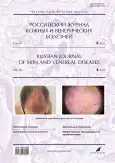Photogallery. Juvenile hemangiomas
- Authors: Dubensky V.V.1, Dubenskiy V.V.1
-
Affiliations:
- Tver State Medical University
- Issue: Vol 26, No 4 (2023)
- Pages: 421-426
- Section: PHOTO GALLERY
- Submitted: 19.05.2023
- Accepted: 27.06.2023
- Published: 08.09.2023
- URL: https://rjsvd.com/1560-9588/article/view/430370
- DOI: https://doi.org/10.17816/dv430370
- ID: 430370
Cite item
Abstract
Juvenile hemangiomas can occur from the first months of life, with the prevalence of superficial juvenile hemangiomas (76.1%), more often solitary (83.3%).
Female infants predominate among the patients, with a 2:1 ratio.
Localization on the skin of the face and scalp is determined in 30% of cases; the remaining juvenile hemangiomas are located on the skin of the trunk and extremities.
Hemangiomas are mostly peripheral and small in size (10–20 mm), superficially and up to 5 mm deep.
The most frequent complication of juvenile hemangiomas is ulceration, both as a consequence of exophytic growth and treatment methods.
The predominance of arterial intramedullary blood flow was found at ultrasound diagnosis, however, variants of 2-phase blood flow can also occur, which requires additional ultrasound examination of all cases of juvenile hemangiomas.
We offer the publication of a photo gallery on this problem.
Full Text
About the authors
Vladislav V. Dubensky
Tver State Medical University
Author for correspondence.
Email: dubensky.vladislav@yandex.ru
Russian Federation, Tver
Valeriy V. Dubenskiy
Tver State Medical University
Email: valerydubensky@yandex.ru
MD, Dr. Sci. (Med.), Professor
Russian Federation, TverReferences
Supplementary files
















